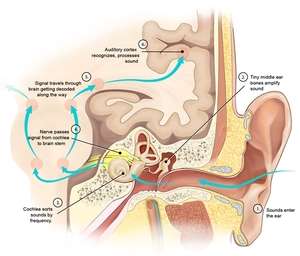Earaches are a common symptom that usually indicates an ear infection. They may cause a great deal of discomfort, but usually resolve even without treatment over a five to seven day period. On the other hand ear pain associated with bleeding from an ear canal is usually the sign of a more serious condition ‘” a perforated eardrum. A perforated or ruptured eardrum may feel like an ordinary ear infection initially with ear pain and a sensation of ear fullness; but a garden variety earache is rarely associated with bleeding from the ear canal. When this symptom occurs it’s time to see a doctor quickly. If left untreated, a ruptured eardrum can lead to complete or partial hearing loss in the affected ear ‘” a situation few people want.
What Causes a Ruptured Eardrum?
The eardrum consists of a very thin membrane that stretches in response to increased pressure ‘” at least up to a point. When exposed to pressure that exceeds its ability to adapt, it can rupture or tear. The most common cause of a perforated eardrum is infection involving the middle ear. Infection causes pressure build-up which puts more stress on the membrane than it can handle, leading to rupture. This may be associated with severe ear pain with temporary relief after the rupture since the pressure has been equalized. Unfortunately, the ear is now open to viruses and bacteria, increasing the risk of an even more serious infection of the inner ear.
Other causes of a perforated eardrum are loud noises, sudden pressure changes (during air flight) or scuba diving, and rupture from objects that are stuck in the ear. This is why it’s important not to use a q-tip or other object to remove wax from the ear canals. Not only does it further push the wax into the canal, but it also increases the risk of a painful rupture.
What Are Other Symptoms of a Ruptured Eardrum
In addition to bleeding or discharge from the ear canal, a person suffering from a ruptured eardrum may experience dizziness related to inner ear involvement. There may be hearing loss or abnormal noises present in the affected ear. These are all signs that a thorough evaluation is needed to prevent permanent hearing loss.
What Should You Do If You Suspect a Perforated Eardrum?
Get in to see a doctor as quickly as possible. If you can’t an immediate appointment, go to the emergency room. A ruptured eardrum can usually be seen using an otoscope, the instrument your doctor routinely uses to check for ear problems, but small tears may be missed. If none is seen, but perforation is still suspected, a test called a tympanogram may be performed. This test can detect small holes and tears that may have been missed on visual exam.
How Is It Treated?
Fortunately, most ruptured eardrums repair themselves over several weeks ‘” thanks to the amazing ability of the body to rebuild and mend. While healing, it’s important to keep the ear canal scrupulously clean and free of moisture. If the perforation fails to heal after several weeks, a surgery may be needed to repair the tear using skin from another part of the ear.
References:
Harrison’s Textbook of Medicine


